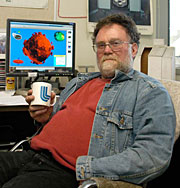- Number 303 |
- January 18, 2010
LLNL's Dearborn tackles the asteriod threat

Dave Dearborn
Dave Dearborn’s mission is to keep us safe from incoming asteroids.
Dearborn, a physicist in DOE's Lawrence Livermore National Laboratory, serves on a research panel, spearheaded by the National Academy of Sciences, tasked with evaluating methods to divert potentially hazardous objects—those that could hit Earth in the next 100 years.
“An object of this size would have approximately 1 billion tons of mass,” says Dearborn, of LLNL's’s Science and Technology Principal Directorate. “If it traveled at 30 kilometers per second, it would have explosive power equivalent to 100 billion tons of TNT.” In the event a 1-kilometer-size asteroid impacted Earth, the energy released would have global-scale effects.
The panel is considering several diversion technologies, but for Dearborn, nuclear explosives provide the best solution for dealing with catastrophic asteroids.
Dearborn has extensive experience in designing and testing nuclear and conventional explosives and leads the effort to model the impact of a nuclear explosion on an object’s trajectory in space.
NASA is evaluating impactor technology as a possible solution to diverting asteroids. These devices are designed to collide with the asteroid and change its momentum.
“Tests during NASA’s Deep Impact mission showed that impactors can divert smaller bodies, such as asteroids up to approximately 300 meters in size,” says Dearborn.
Another diversion method is the gravity tractor. In this deflection scheme, the gravitational attraction between the asteroid and a spacecraft allows the spacecraft to move the asteroid off course over time, a process that could take years or even decades.
According to Dearborn, this method may be advantageous for only about 5 percent of asteroids and would require major advances in technology before a spacecraft could carry out the mission successfully. Lasers have also been proposed, but even the most powerful lasers in existence would have to function over thousands of years to have any effect.
Methods that rely on elaborate launching stations or that add components to spacecraft could require putting an extra 20 tons of material into deep space. Conversely, nuclear explosives, with their high energy-to-weight ratio, would need comparatively less material to do the same job.
Not everyone shares Dearborn’s enthusiasm and confidence in using nuclear explosives to deflect asteroids. Yet, in the face of skepticism, Dearborn remains resolute. “Part of my job is to respond to criticism and to dispel myths related to the use of nuclear explosives,” he says.
Ultimately, Congress, the National Science Foundation, and NASA will use the information to determine the most effective strategy for deflecting asteroids.Submitted by DOE's Lawrence Livermore National Laboratory
